Related Research Articles

Slide guitar is a technique for playing the guitar that is often used in blues music. It involves playing a guitar while holding a hard object against the strings, creating the opportunity for glissando effects and deep vibratos that reflect characteristics of the human singing voice. It typically involves playing the guitar in the traditional position with the use of a slide fitted on one of the guitarist's fingers. The slide may be a metal or glass tube, such as the neck of a bottle. The term bottleneck was historically used to describe this type of playing. The strings are typically plucked while the slide is moved over the strings to change the pitch. The guitar may also be placed on the player's lap and played with a hand-held bar.
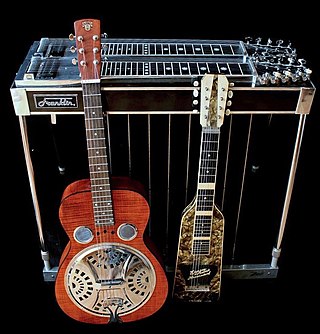
A steel guitar is any guitar played while moving a steel bar or similar hard object against plucked strings. The bar itself is called a "steel" and is the source of the name "steel guitar". The instrument differs from a conventional guitar in that it is played without using frets; conceptually, it is somewhat akin to playing a guitar with one finger. Known for its portamento capabilities, gliding smoothly over every pitch between notes, the instrument can produce a sinuous crying sound and deep vibrato emulating the human singing voice. Typically, the strings are plucked by the fingers of the dominant hand, while the steel tone bar is pressed lightly against the strings and moved by the opposite hand.

The pedal steel guitar is a console-type of steel guitar with pedals and knee levers that change the pitch of certain strings to enable playing more varied and complex music than other steel guitar designs. Like all steel guitars, it can play unlimited glissandi and deep vibrati—characteristics it shares with the human voice. Pedal steel is most commonly associated with American country music and Hawaiian music.

The lap steel guitar, also known as a Hawaiian guitar, is a type of steel guitar without pedals that is typically played with the instrument in a horizontal position across the performer's lap. Unlike the usual manner of playing a traditional acoustic guitar, in which the performer's fingertips press the strings against frets, the pitch of a steel guitar is changed by pressing a polished steel bar against plucked strings. Though the instrument does not have frets, it displays markers that resemble them. Lap steels may differ markedly from one another in external appearance, depending on whether they are acoustic or electric, but in either case, do not have pedals, distinguishing them from pedal steel guitars.
Copedent is a term used to describe the tuning and pedal arrangement on a pedal steel guitar and is unique to that instrument. Typically expressed in the form of a table or chart, the word is a portmanteau of "chord–pedal–arrangement and is pronounced "co-PEE-dent". It was coined in 1969 by Steel Guitar Hall of Fame member Tom Bradshaw and first reached a wide audience in a 1972 article in Guitar Player magazine. A complete copedent includes the order of strings, their tuning, string gauges, and whether a string is plain or wound; it also indicates how any string's pitch is changed by applying a foot pedal or a knee lever. It has become an international standard used by steel guitar players and manufacturers to describe the specifications of these instruments.

Paul V. Franklin is an American multi-instrumentalist, known mainly for his work as a steel guitarist. He began his career in the 1970s as a member of Barbara Mandrell's road band; in addition he toured with Vince Gill, Mel Tillis, Jerry Reed and Dire Straits. He has since become a prolific session musician in Nashville, playing on more than 500 albums. He has been named by the Academy of Country Music as Best Steel Guitarist on several occasions. He was inducted into the Steel Guitar Hall of Fame in 2000 and the Musicians Hall of Fame and Museum in 2019. With thirty, Franklin is the most nominated person in CMA history and is notable for having been nominated for the Country Music Association Award for Musician of the Year twenty nine times but has yet to win.

The console steel guitar is any type of electric steel guitar that is built in a frame supported by legs. It may be a lap steel or a pedal steel. Console steel guitars are typically heavier instruments that have multiple necks and/or more than six strings per neck and are therefore not manageable on the player's lap. This type of instrument was created when players in the late 1940s needed to play in different keys and with different chords than the lap steel afforded. To do this, they added additional necks to a lap steel. The player could then easily switch to a different neck on the same instrument, but this made the instrument so heavy and cumbersome that it could not be easily held on the lap. Trying to solve the problem with multiple necks led to the invention of the pedal steel guitar in the 1950s.

E9 tuning is a common tuning for steel guitar necks of more than six strings. It is the most common tuning for the neck located furthest from the player on a two-neck console steel guitar or pedal steel guitar while a C6 neck is the one closer to the player. The E9 is a popular tuning for single neck instruments of eight or more strings. This tuning has evolved in the last half of the twentieth century with input from prominent performers including Jimmy Day, Ralph Mooney and Buddy Emmons to support optimal chord and scale patterns across a single fret on the 10-string pedal steel guitar.

Doug Jernigan is an American pedal steel guitarist and Dobro player. He is known for his infusion of country music with jazz using fast single-note solos. He was one of the first steel guitarists to play solos at speeds rivaling the banjo and fiddle. Jernigan performed with Faron Young, Johnny Paycheck, Vassar Clements, Little Jimmy Dickens, and Lorrie Morgan and was a Nashville recording session musician and teacher for decades. As of 2020, he has been the featured artist on nine instrumental albums in both jazz and country genres. He was inducted into the Steel Guitar Hall of Fame in 1994.
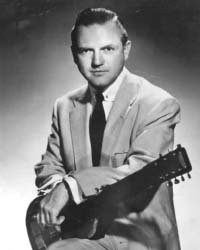
Gerald Lester Byrd was an American musician who played the lap steel guitar in country and Hawaiian music, as well as a singer-songwriter and the head of a music publishing firm. He appeared on numerous radio programs.
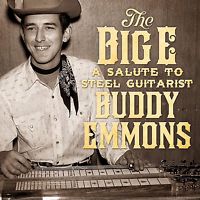
Buddy Gene Emmons was an American musician who is widely regarded as the world's foremost pedal steel guitarist of his day. He was inducted into the Steel Guitar Hall of Fame in 1981. Affectionately known by the nickname "Big E", Emmons' primary genre was American country music, but he also performed jazz and Western swing. He recorded with Linda Ronstadt, Gram Parsons, The Everly Brothers, The Carpenters, Jackie DeShannon, Roger Miller, Ernest Tubb, John Hartford, Little Jimmy Dickens, Ray Price, Judy Collins, George Strait, John Sebastian, and Ray Charles and was a widely sought session musician in Nashville and Los Angeles.

Lloyd Lamar Green is an American steel guitarist noted for his extensive country music recording session career in Nashville performing on 116 No.1 country hits including Tammy Wynette's “D-I-V-O-R-C-E” (1968), Charlie Rich's “Behind Closed Doors” (1973), The Oak Ridge Boys’ “Elvira” (1981), and Alan Jackson's “Remember When” (2004). Green was a one of an inner circle of elite recording studio musicians known colloquially as the Nashville A-Team. In a career beginning in the mid 1960s and spanning a quarter-century, Green performed on more than 5000 recordings helping to create hits for scores of artists such as Charley Pride, The Byrds, Johnny Cash, The Monkees, Don Williams, Paul McCartney, Bob Dylan, and many others. His 1968 performance on the Byrds' landmark album Sweetheart of the Rodeo, influenced generations of non-mainstream country guitarists. He was featured on Ken Burns' Country Music documentary film in 2019. Green was inducted into the Steel Guitar Hall of Fame in 1988.
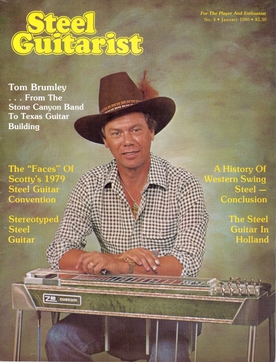
Thomas Rexton Brumley was an American pedal steel guitarist and steel guitar manufacturer. In the 1960s, Brumley was a part of the sub-genre of country music known as the "Bakersfield sound". He performed with Buck Owens and the Buckaroos on hits such as "Cryin' Time" and "Together Again". His solo on "Together Again" received particular acclaim by critics. Brumley later spent a decade with Ricky Nelson and performed on "Garden Party" and the In Concert at the Troubadour, 1969 album.

JayDee Maness is an American pedal steel guitarist who is a veteran session musician in Los Angeles. He is known for his work with Gram Parsons, the Byrds, Buck Owens and the Buckaroos, Ray Stevens, Vince Gill, and the Desert Rose Band. Maness received The Academy of Country Music's "Steel Guitarist of the Year" award 18 times and was inducted into the Steel Guitar Hall of Fame in 2003.
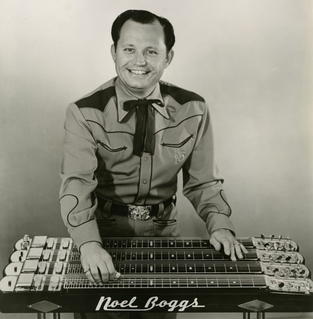
Noel Edwin Boggs was an American musician who was a virtuoso on the lap steel guitar and a member of the Steel Guitar Hall of Fame. He was one of the pioneers in electric steel guitar who helped popularize the instrument beyond its native Hawaiian music into other genres of American popular music, specifically Western Swing. Boggs played and recorded with almost every major artist in the genre including Bob Wills and His Texas Playboys (1944-1945) and Spade Cooley's Dance Band. Bob Wills' band helped define the guitar's role in western swing; Wills discovered and coached innovative guitarists who deeply influenced country, rock and jazz music. Boggs appeared on some 2000 recordings as a soloist and his playing was prominent on several of Wills’ hits that became Western swing standards, including "Roly Poly" and "Stay a Little Longer".

Herbert Leroy Remington (1926–2018) was an American lap steel guitarist who played Western swing music with Bob Wills and the Texas Playboys from 1946 to 1949. A member of the International Steel Guitar Hall of Fame (1979), Remington is known for his Hawaiian style playing combined with swing-based jazz soloing. One of his signature recordings was Bob Wills' "Boot Heel Drag", which appeared on the B-side of Wills' classic hit, "Faded Love". He is also known for "Remington's Ride", a song that became a standard for steel players. Indiana-born Remington studied Hawaiian steel guitar as a youth, but serendipitously got into Western swing music in his teens and became one of the genres most renowned steel guitarists.
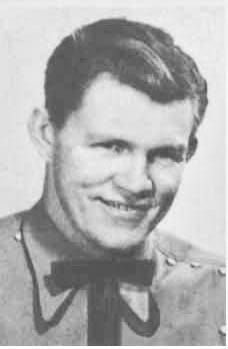
Forrest "Bud" Isaacs (1928–2016) was an American steel guitarist who made country music history in 1954 as the first person to play pedal steel guitar on a hit record. He is known for his playing his innovative technique on Webb Pierce's 1954 recording of a song called "Slowly" which became a major hit for Pierce and was one of the most-played country songs of 1954. Isaacs was the first to push a pedal while the strings were still sounding to create a unique bending of notes from below up to join an existing note; this was not possible on older lap steel guitars. The stunning effect he created was embraced by country music fans and many lap steel artists rushed to get pedals to imitate the unique bending chords that he played. Music historians pinpoint the actual dawning of country music's modern era to Isaac's performance on this song. He became a much-favored session player and performed on 11 top country records the year following the release of "Slowly". Even though pedal steel guitars had been available for over a decade before this recording, the instrument emerged as a crucial element in country music after the success of this song.
Zane Beverly Beck (1927–1985) was an American steel guitarist and builder of pedal steel guitars. He is best known for his 1952 innovation of adding knee levers to the pedal steel guitar to alter the pitch of certain strings, a feature which has become a standard on all modern-day instruments. Other inventors had patented crude knee-operated devices as far back as 1933, but none were successful. Beck revolutionized the concept into a durable and reliable mechanism and was the first to put knee levers on production guitars. He became a member of the International Steel Guitar Hall of Fame (1991). As a musician, he performed on the Grand Ole Opry and Shreveport's Louisiana Hayride. Beck formed the ZB Music Company which manufactures steel guitars, later called BMI.

Jimmy Day was an American steel guitarist active in the 1950s and 1960s whose career in country music blossomed about the time the pedal steel guitar was invented after pedals were added to the lap steel guitar. He was a pioneer on pedal steel in the genres of Western swing and Honky tonk and his modifications of the instrument's design have become a standard on the modern pedal steel. Day's first job after high school was performing on the Louisiana Hayride as a sideman accompanying developing country artists including Hank Williams, Webb Pierce, Willie Nelson, Jim Reeves, Ray Price and Elvis Presley. He recorded and toured with all these artists and was featured on hit records by of many of them, including Ray Price's, "Crazy Arms" and "Heartaches by the Number". He was a member of Elvis Presley's band for about a year, but, along with fellow bandmate Floyd Cramer, resigned after Presley requested them to re-locate to Hollywood; instead, Day moved to Nashville to work as a session player and Grand Ole Opry musician. He was a member of the Western Swing Hall of Fame (1994) and the International Steel Guitar Hall of Fame (1999). Day died of cancer in 1999.

The Oahu Music Company was a music education program in the United States during the 1930s and 1940s to teach students to play the Hawaiian Guitar. Popular culture in America became fascinated with Hawaiian music during the first half of the twentieth century and in 1916, recordings of indigenous Hawaiian instruments outsold every other genre of music in the U.S. By 1920, sales of Hawaiian guitars and instruction had become well established and Oahu Music Company was the leading purveyor of these programs. The organization canvassed nearly every city in the United States, often door-to-door, selling both their Oahu-brand instruments and lessons for young people to join their weekly classes.
References
- ↑ Bradshaw, Kelly (September 1, 2006). "Steel Guitar Hall of Fame Induction". songwriter.com. Retrieved 11 April 2021.
- 1 2 "Steel Guitar Hall of Fame/Inductees/ Tom Bradshaw". scottysmusic.com. Retrieved April 13, 2021.
- 1 2 Jarnow, Jesse (January 12, 2020). "The Endless Potential Of The Pedal Steel Guitar, An Odd Duck By Any Measure". npr.org. NPR. Retrieved April 13, 2021.
- ↑ Painter, Brian (April 27, 2007). "State's notable role in steel guitar's history". The Daily Oklahoman (Oklahoma City). p. 3–A. Retrieved April 20, 2021.
- 1 2 3 4 5 6 7 8 9 10 11 12 13 14 15 16 Selfe, Ned (May 1, 1981). "SG Interviews: Tom Bradshaw". Steel Guitarist Magazine. 6 (May, 1981): 49.
- ↑ Morse, Harold (March 15, 1978). "Moonlight, Magic and Jerry Byrd". No. Vol 67, No. 74. Honolulu Star–Bulletin. p. D–14. Retrieved April 21, 2021.
- ↑ Bradshaw, Tom (May 9, 2003). "Steel Guitar Forum/Pedal Steel/Pronunciation". steelguitarforum.com. Retrieved April 24, 2021.